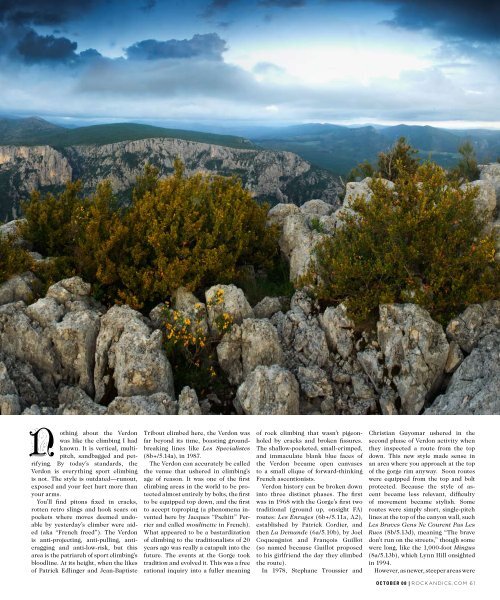The Verdon GorGe is Technical, spicy and run ouT, so why is This ...
The Verdon GorGe is Technical, spicy and run ouT, so why is This ...
The Verdon GorGe is Technical, spicy and run ouT, so why is This ...
You also want an ePaper? Increase the reach of your titles
YUMPU automatically turns print PDFs into web optimized ePapers that Google loves.
Nothing about the <strong>Verdon</strong><br />
was like the climbing I had<br />
known. It <strong>is</strong> vertical, multipitch,<br />
s<strong>and</strong>bagged <strong>and</strong> petrifying.<br />
By today’s st<strong>and</strong>ards, the<br />
<strong>Verdon</strong> <strong>is</strong> everything sport climbing<br />
<strong>is</strong> not. <strong>The</strong> style <strong>is</strong> outdated—<strong>run</strong>out,<br />
exposed <strong>and</strong> your feet hurt more than<br />
your arms.<br />
You’ll find pitons fixed in cracks,<br />
rotten retro slings <strong>and</strong> hook scars on<br />
pockets where moves deemed undoable<br />
by yesterday’s climber were aided<br />
(aka “French freed”). <strong>The</strong> <strong>Verdon</strong><br />
<strong>is</strong> anti-projecting, anti-pulling, anticragging<br />
<strong>and</strong> anti-low-r<strong>is</strong>k, but th<strong>is</strong><br />
area <strong>is</strong> the patriarch of sport climbing’s<br />
bloodline. At its height, when the likes<br />
of Patrick Edlinger <strong>and</strong> Jean-Bapt<strong>is</strong>te<br />
Tribout climbed here, the <strong>Verdon</strong> was<br />
far beyond its time, boasting groundbreaking<br />
lines like Les Special<strong>is</strong>tes<br />
(8b+/5.14a), in 1987.<br />
<strong>The</strong> <strong>Verdon</strong> can accurately be called<br />
the venue that ushered in climbing’s<br />
age of rea<strong>so</strong>n. It was one of the first<br />
climbing areas in the world to be protected<br />
almost entirely by bolts, the first<br />
to be equipped top down, <strong>and</strong> the first<br />
to accept toproping (a phenomena invented<br />
here by Jacques “Pschitt” Perrier<br />
<strong>and</strong> called moulinette in French).<br />
What appeared to be a bastardization<br />
of climbing to the traditional<strong>is</strong>ts of 20<br />
years ago was really a catapult into the<br />
future. <strong>The</strong> events at the Gorge took<br />
tradition <strong>and</strong> evolved it. Th<strong>is</strong> was a free<br />
rational inquiry into a fuller meaning<br />
of rock climbing that wasn’t pigeonholed<br />
by cracks <strong>and</strong> broken f<strong>is</strong>sures.<br />
<strong>The</strong> shallow-pocketed, small-crimped,<br />
<strong>and</strong> immaculate blank blue faces of<br />
the <strong>Verdon</strong> became open canvases<br />
to a small clique of forward-thinking<br />
French ascention<strong>is</strong>ts.<br />
<strong>Verdon</strong> h<strong>is</strong>tory can be broken down<br />
into three d<strong>is</strong>tinct phases. <strong>The</strong> first<br />
was in 1968 with the Gorge’s first two<br />
traditional (ground up, onsight FA)<br />
routes: Les Enrages (6b+/5.11a, A2),<br />
establ<strong>is</strong>hed by Patrick Cordier, <strong>and</strong><br />
then La Dem<strong>and</strong>e (6a/5.10b), by Joel<br />
Coqueugniot <strong>and</strong> Franço<strong>is</strong> Guillot<br />
(<strong>so</strong> named because Guillot proposed<br />
to h<strong>is</strong> girlfriend the day they climbed<br />
the route).<br />
In 1978, Stephane Troussier <strong>and</strong><br />
Chr<strong>is</strong>tian Guyomar ushered in the<br />
second phase of <strong>Verdon</strong> activity when<br />
they inspected a route from the top<br />
down. Th<strong>is</strong> new style made sense in<br />
an area where you approach at the top<br />
of the gorge rim anyway. Soon routes<br />
were equipped from the top <strong>and</strong> bolt<br />
protected. Because the style of ascent<br />
became less relevant, difficulty<br />
of movement became styl<strong>is</strong>h. Some<br />
routes were simply short, single-pitch<br />
lines at the top of the canyon wall, such<br />
Les Braves Gens Ne Courent Pas Les<br />
Rues (8b/5.13d), meaning “<strong>The</strong> brave<br />
don’t <strong>run</strong> on the streets,” though <strong>so</strong>me<br />
were long, like the 1,000-foot Mingus<br />
(8a/5.13b), which Lynn Hill onsighted<br />
in 1994.<br />
However, as newer, steeper areas were<br />
O c t O b e r 0 8 | rock a n d i c e .co m 6 1


